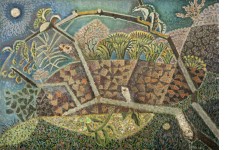Γλυπτική 15Σχέδιο 72Ελαιογραφία 74Τέμπερα 5Μικτή Τεχνική 30Υδατογραφία 15Χαρακτική 6Ακρυλικά 9Gouache 5Αυγοτέμπερα 2
Ειδικές Πληροφορίες για τον Καλλιτέχνη
TITΛΟΣ ΕΡΓΟΥΚλαδί και φεγγάρι
ΔΙΑΣΤΑΣΕΙΣ ΕΡΓΟΥΎψος : 40
Πλάτος : 58,5
ΥΛΙΚΟ ΚΑΤΑΣΚΕΥΗΣΜικτή τεχνική (Μικτή τεχνική με λάδι)
ΥΠΟΓΡΑΦΗ ΚΑΛΛΙΤΕΧΝΗΚάτω Δεξιά
ΧΡΟΝΟΛΟΓΗΣΗ01-01-1948
ΕΛΕΓΧΟΣ ΓΝΗΣΙΟΤΗΤΑΣΔεν έχει ελεγχθεί

Footnotes
Painted in 1948.
Provenance
Maria P. Ralli collection.
P. Kyriakopoulos collection.
N. Canellopoulos collection, Athens.
Private collection, Athens.
Exhibited
Venice, La Biennale di Venezia, 1950 (listed in the exhibition catalogue, no. 39, p. 332).
London, Leicester Galleries, Ghika, February 5-26, 1953.
London, Whitechapel Gallery, Ghika, Paintings 1934-1968, July 7 1968 - August 8, 1968, no. 12 (listed in the exhibition catalogue).
Athens, National Gallery - A. Soutzos Museum, Ghika, May 1973, no. 35 (listed in the exhibition catalogue).
Literature
Ghika, Leicester Galleries, London 1953, no. 18.
The Atlantic, June 1955, vol. 195, p. 129 (illustrated).
Perspectives of Greece, an Atlantic Month Supplement, Intercultural Publications, New York 1955, p. 35 (illustrated).
The Charioteer, a Quarterly Review of Modern Greek Culture, vol. 1, no. 2, Autumn 1960, p. 60 (illustrated).
Ghika, Paintings, Drawings, Sculpture, Boston Book and Art Shop, Boston 1964, pl. 58 (illustrated).
Ghika, Peintures, Dessins, Sculptures, Cahiers d' Art, Paris 1965, fig. 58.
N. Chadjikyriakos-Ghika, in Memoriam, The Academy of Athens, Athens 1995, p. 15 (mentioned).
K.C. Valkana, Nikos Hadjikyriakos-Ghika, His Painting Oeuvre, Benaki Museum edition, Athens 2011, fig. 25, p. 141 (illustrated).
The work of a mercurial and inventive mind whose rich imagination and acute sensibility could turn ordinary subjects like common plants into an otherworld of magic1, Bough and moon from 1948 is a masterful view of Hydra's2 landscape with its characteristic stone walls and insular flora. The middle of the composition is dominated by two large boughs with branches extending across the entire pictorial surface, adhering to the grade of the sloping landscape and, therefore, to the rhythm of nature and of the work itself. The moon3 dictates the cool tonalities and intense juxtapositions of light and dark areas, further animated by the textured surface overlaid by drips of paint.4
"In the 1940s, Ghika devoted himself to the examination of what is meant by objectivity. This he did with the controlled though passionate lyricism which is characteristic of him. In his own particular way he tries to seek out the secret, plastic life that inhabits every object. But Ghika is a man of prudence. There is in his work a classical proportion, which might make it disagreeably severe if the artist's hand were not guided by one invaluable element in his nature: that of elegance. He looks at the objectiveness of the world with the amazement of a child who sees everything for first time. In the paintings dated 1948 we can see that once he has found the secret he was looking for, he re-assembles what he has taken to pieces. And on the grandest scale: like a great nobleman who asks no security when he lends to Nature."5
1. M. Hadjidakis, "Some Aspects of Modern Greek Art" in Perspective of Greece, an Atlantic Monthly Supplement, Intercultural Publications, New York 1955, p. 33.
2. The landscape of Hydra, with its well-balanced lines empowered Ghika to open a fruitful dialogue with his native land, combining his cubist experience with the island's geometric forms and archetypal volumes. See M. Achimastou-Potamianou, "The Art of Ghika" in The Greek Painters, vol. II, 20th Century, Melissa editions, Athens 1975, pp. 332, 336-337.
3. The moon was a source of inspiration for the 19th c. French symbolist poets, particularly Charles Baudelaire and his poem Les Bienfaits de la Lune, while Baudelaire's transient and hallucinatory images influenced the painters of the New York School in the 1940s (compare J. Pollock, The moon woman, 1942, Guggenheim Foundation, Venice).
4. See K.C. Valkana, Nikos Hadjikyriakos-Ghika, His Painting Oeuvre [in Greek], Benaki Museum edition, Athens 2011, pp. 138, 140.
5. M. Raynal, preface to the catalogue of the First Exhibition in England of Paintings and Sculpture by Ghika, The Leicester Galleries, London 1953.